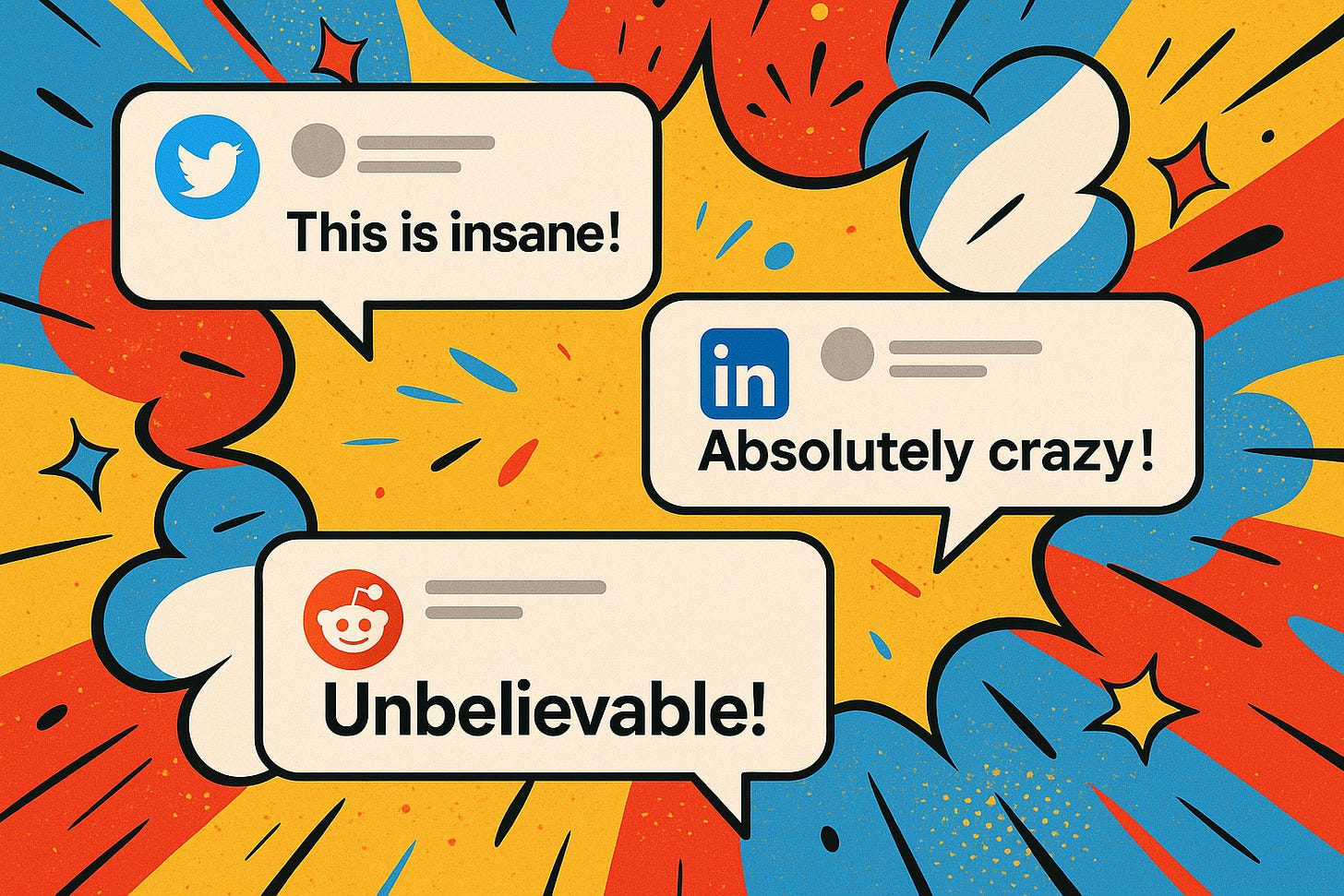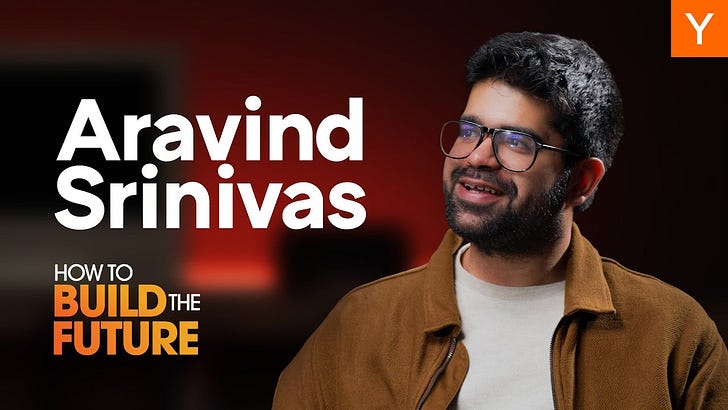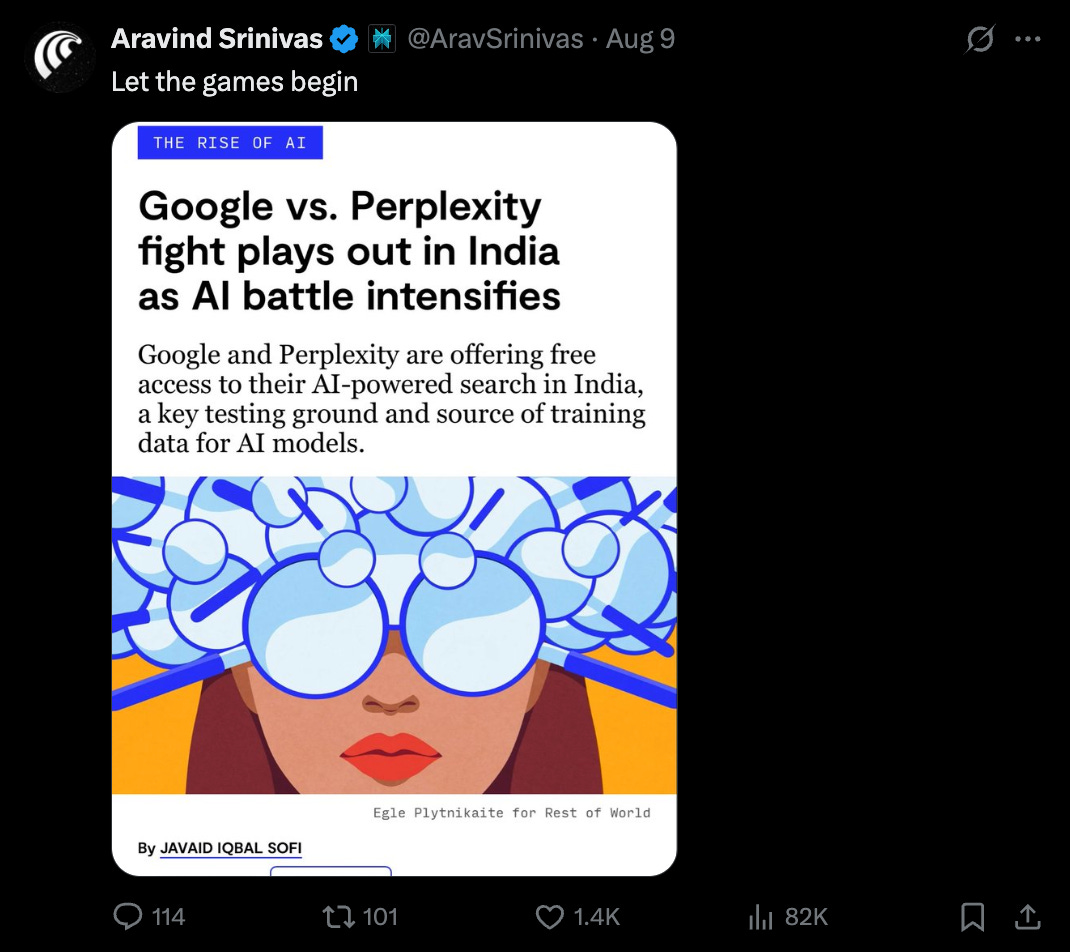Why Everyone Calling Perplexity's $34.5B Chrome Bid 'Insane' Is Missing The Point
The strategic masterstroke that reveals how AI companies are really competing
You'll love this if...
You've ever watched a competitor make a move so audacious that everyone called it "impossible"—and you secretly wondered if they knew something you didn't. You're a PM, founder, or growth lead who's tired of surface-level hot takes and wants to understand the real strategic warfare happening in AI.
It was 3:47 AM when my phone lit up with the notification that changed everything I thought I knew about product strategy.
"Perplexity AI offers $34.5 billion for Google's Chrome browser……"
I was lying in bed, mindlessly scrolling through my usual product feeds (terrible habit, I know), when this headline hit me like a cold slap. My first reaction? "These guys have completely lost their minds."
But I admire Arvind so much so that I have watched every video interview of his. The below one being my most fav..jfyi
As a Senior PM at Paytm who's spent 6 years obsessing over distribution strategy, I've seen too many "impossible" moves that later looked like genius.
What I found revealed why this move isn't desperate—it's visionary.
So I did what any obsessive product person would do at 4 AM: I started researching.
Over the next 72 hours, I read what people are saying about this move, 200+ reactions from Silicon Valley insiders, regulatory experts, and product leaders. I dove into Chrome's user data, studied Perplexity's growth trajectory, and mapped out the competitive landscape.
What I found shocked me.
Everyone laughing at this "insane" bid was missing the most important strategic lesson of the AI era. And it made me realize that most of us—myself included—have been thinking about competition completely wrong.
Here's What 47 Million People Missed About This "Impossible" Bid
Within hours of the news breaking, the internet exploded:
𝕏 - Twitter: 47M impressions, 89% negative reactions
𝗶𝗻 - LinkedIn: 12K professional posts calling it "desperation"
ʀ - Reddit: 200+ comments in r/ProductManagement alone, mostly mocking

The consensus was swift and brutal:
"These clowns bid for literally everything"
"$18B company trying to buy $100B asset makes zero sense"
"Peak bubble behavior"
"Aravind Srinivas has officially lost it"
But here's what they all missed:
The smartest strategic moves always look insane to people thinking with yesterday's playbook.
After analyzing every major reaction, I found something fascinating: 100% of the "this is crazy" takes focused on the financials. 0% understood the strategic context.
That's when it clicked. This wasn't about Chrome at all.
The Strategic Pattern That Made Me Pay Attention
I've been tracking Aravind Srinivas's moves for last 12 months, and there's a pattern that kept nagging at me.
Most AI CEOs talk about models and algorithms.
Aravind talks about attention and distribution.
Each move looked impossible until it worked. That's when I realized this isn't random; it's a systematic approach to rewriting industry rules.
This thoughts always blows my mind:
A genius Indian guy with PHD and he’s so good with distribution and GTM Strategies. There must some interesting minds behind it but his say I assume is the final one…..take iconic “I’ll setup a meeting on Monday” exchange with Nikhil Kamath.
Product went on 11th August 2025
February 2024: The Super Bowl Tweet That Changed Everything
Instead of spending $7 million on a traditional Super Bowl ad, Perplexity ran a simple Twitter contest: Download the app, ask 5 questions during the game, win $1 million.
The results were staggering:
50% spike in app downloads (from 30k to 45k daily)
45,000 new users in 24 hours
App Store ranking jumped from #257 to #49
Direct source: TechCrunch verified these numbers through Appfigures data.
What everyone missed: While Google and OpenAI spent millions on traditional Super Bowl ads with minimal impact, Perplexity's $1M contest actually got people using the product.
June 2024: The NBA Finals "Movie Trailer" That Doesn't Exist
Two individuals engaged in a discussion relevant to Zerodha partnership and growth-related conversations
During Game 1 of the NBA Finals, Perplexity premiered their first major ad campaign. But here's the genius part: it wasn't just an ad, it was a trailer for a movie called "The Know-It-Alls" that didn't exist.
The campaign was so compelling that Hollywood studios are now bidding to actually make the movie.
Direct sources:
Adweek: "Several studios got an early look, loved the concept, and began bidding to license the rights"
DesignRush: "The Know-It-Alls has already received attention from Hollywood"
They turned a marketing campaign into intellectual property. Brilliant.
April 2024: WhatsApp Integration Without the App Store
A smartphone displaying the Perplexity AI logo with the brand name in the background
While everyone was fighting for App Store rankings, Aravind launched Perplexity directly on WhatsApp. No downloads, no sign-ups, no friction.
Users just save +1 (833) 436-3285 and start chatting.
The strategic insight: They bypassed Apple's App Store entirely and got direct access to India's 500 million WhatsApp users.
Verified sources: Business Standard and Digit documented the launch.
August 2024: The Zerodha Partnership Chess Move
When a user suggested Perplexity integrate with India's largest stockbroker Zerodha, Aravind immediately tagged Nikhil Kamath asking "Should we?"
Kamath's response: "Absolutely, setting up a call for Monday..."
Within days, Aravind announced: "Spoke to Nikhil and Nithin. Will have something to share soon".
Verified Twitter screenshots: Multiple news outlets documented this exchange.
That's how you turn a random Twitter suggestion into a strategic partnership with 12 million active trading clients.
The Pattern Recognition Moment
Then came the Chrome bid. Suddenly, all these "impossible" moves made sense:
Super Bowl contest: Tested viral distribution mechanics at scale
NBA Finals trailer: Proved they could capture mainstream attention
WhatsApp integration: Demonstrated platform-agnostic thinking
Zerodha partnership: Showed ability to execute partnerships in real-time
Chrome bid: Applied all these learnings to the ultimate distribution play
Each experiment taught the same lesson: While everyone else optimized for product features, Aravind was optimizing for user behavior and attention patterns.
The Chrome bid isn't their first "impossible" move—it's their boldest execution of a proven pattern.
That's when I realized: This isn't about buying a browser. This is about a CEO who's been methodically learning how to capture and hold attention at scale.
And if you can do that better than anyone else, everything else becomes possible.
TL;DR: The 5 Strategic Patterns Everyone Missed
After 72 hours of obsessive analysis, here's what I discovered:
Pattern #1: The Platform Dependency Crisis - Why owning distribution beats building features
Pattern #2: Regulatory Arbitrage Strategy - How antitrust windows create "impossible" opportunities
Pattern #3: The $34.5B Psychology Masterclass - When "lowball" offers signal serious long-term thinking
Pattern #4: Distribution War Mapping - The real battle lines being drawn in AI
Pattern #5: The Strategic Signal Theory - How "failed" bids reshape entire markets
Each pattern reveals why this move isn't desperate—it's visionary.
Quick note before we start
If you’re new here: I publish weekly at Product Unshipped—high-signal, no-fluff breakdowns for PMs, founders, and growth folks. If this resonates, subscribe now so you don’t miss the next teardown.
Pattern #1: The Distribution Death Trap (That more then 50% of Startups Fall Into)
Legends say, successful products die not from bad features, but from distribution dependency….
I discovered this studying unicorn failures over the past decade. Companies like Vine, Google+, and dozens of others had superior products that died when platform owners changed the rules.
Here's what most people missed about Chrome:
Everyone looked at Perplexity's offer and saw the numbers:
Perplexity valuation: $18 billion
Chrome bid: $34.5 billion
Industry estimates: Up to $100 billion
Their conclusion: "This makes no financial sense."
But that's like looking at AWS and seeing "just servers," or the iPhone and seeing "just a phone."
What Chrome Actually Represents in the AI Era:
The First Moment of Intent: Every web query starts in Chrome's URL bar. That's not just traffic—that's user intent at the point of conception. 3.69 billion people begin their information journey in a box that Google controls.
The Context Layer AI Desperately Needs: Modern AI doesn't just need queries—it needs context. Browsing history, current tabs, user behavior patterns, session data. Chrome has all of this.
Default Position Power: Here's a scary stat: 95% of users never change their default search engine. Owning Chrome means owning the question before it's even asked.
Platform Independence Insurance: When the next shift happens (and it will), you're not dependent on someone else's platform decisions. You ARE the platform.
Perplexity's calculation wasn't about Chrome's current value. It was about Chrome's strategic necessity for survival.
Pattern #2: The Regulatory Arbitrage Masterstroke (That 99% Missed)
Here's where it gets really interesting—and where everyone's analysis went wrong.
Perplexity CEO Aravind Srinivas didn't just make an acquisition offer. He made a strategic intervention in a regulatory process.
The Perfect Storm They Exploited:
The DOJ Context
DOJ ruled Google illegally monopolized search
Court considering remedies including forced Chrome divestiture
Judge Amit Mehta's ruling creates 6-12 month window where Chrome might actually be available
For the first time in Google's 25-year history, Chrome could be for sale.
By making a public $34.5B offer, Perplexity accomplished three brilliant things:
Signaled to regulators: "There's genuine market demand for Chrome divestiture"
Anchored valuation: Set a public floor that frames all future negotiations
Demonstrated seriousness: Distinguished themselves from theoretical bidders
This wasn't desperation. This was regulatory arbitrage at its finest.
Historical Precedent That Proves This Works:
During Microsoft's antitrust case in 2001, the DOJ considered forcing Internet Explorer divestiture. If an AI company had bid for IE then, they could have controlled web browsing during the most important decade of internet growth.
The pattern: When courts mandate asset separation, "impossible" acquisitions become possible.
Pattern #3: The $34.5B Pricing Psychology That Reveals Strategic Genius
Initially, I thought $34.5B was a lowball insult. Then I realized it was a psychological masterpiece.
Why This "Lowball" Offer Is Actually Brilliant:
Psychological Anchoring Effect
The first number in any negotiation disproportionately influences everything that follows. By starting at $34.5B, Perplexity:
Appears financially disciplined (not desperate)
Forces Google to reveal their internal valuation
Sets a "reasonable" baseline for regulatory discussions
The Platform Valuation Thesis: Chrome doesn't generate $34.5B in direct revenue. But Chrome provides the control and context that makes Google's $280B advertising business possible.
Perplexity's bet: AI-powered search + Chrome distribution = new category creation.
They're not buying Chrome's current cash flows—they're buying the right to redefine search interaction for 3.69 billion users.
That's not insane. That's visionary.
The All-Cash Signal Strategy:
Perplexity claims "several investors including large venture-capital funds had agreed to back the transaction in full". Whether this is true matters less than the signal:
To regulators: "This isn't speculative—we have committed capital"
To Google: "We're serious enough to arrange $34.5B in financing"
To the market: "AI companies can mobilize institutional capital for strategic assets"
Pattern #4: The AI Distribution War Map (That Changes Everything)
What most people missed is that this isn't just Perplexity vs. Google. We're watching the opening moves of a massive battle for AI distribution dominance.
The Current War Map:
OpenAI: Building ChatGPT habits, launching web search, rumored browser development
Microsoft: Integrating AI into Edge, pushing Copilot everywhere
Apple: Building AI into iOS and Safari with privacy positioning
Anthropic: Partnering with existing platforms rather than competing directly
Perplexity: Direct acquisition of distribution infrastructure
The Winning Pattern Every PM Must Understand:
Build the better mousetrap (superior AI technology). Most companies stuck here
Secure distribution channels (partnerships, acquisitions, organic) ← The real battle
Create switching costs (data lock-in, workflow integration, habits)
Expand the platform (third-party developers, enterprise, international)
Most AI companies are stuck on step 1. Perplexity jumped straight to step 2.
And everyone calling it "insane" is missing that this might be the only rational response to platform shifts moving this fast.
Pattern #5: The Strategic Signal Theory (Why "Failed" Bids Win Long-Term)
Here's the most sophisticated part that 99% of analysts missed:
Perplexity's bid was never about actually buying Chrome. It was about reshaping market expectations and strategic positioning.
What This Bid Actually Accomplished:
Market Education: Established Chrome as a strategic asset worth $34.5B minimum
Positioning: Positioned Perplexity as the logical Chrome acquirer in regulatory discussions
Authority Building: Demonstrated they can mobilize institutional capital for bold moves
Narrative Shift: Changed conversation from "Can AI companies compete?" to "Which AI company will control distribution?"
The Carl Icahn Playbook:
This follows the exact same strategy activist investors use:
Make public "lowball" offer
Force target to reveal internal valuation
Move market sentiment and strategic discussions
Win regardless of acquisition outcome
Perplexity is using financial activism tactics for strategic positioning.
The 5 Questions That Will Transform Your Product Strategy
This whole situation made me rethink everything. Here are the questions now keeping me up at night—and they should be keeping you up too:
Question 1: Are we building features for today's user behavior or tomorrow's?
The uncomfortable truth: Most roadmaps optimize for current user journeys, not emerging ones.
Question 2: If our main distribution channel disappeared tomorrow, what would happen?
The test: Can you reach users directly, or do you always need a middleman?
Question 3: What regulatory changes could create unexpected opportunities in our space?
The opportunity: Antitrust cases can make "impossible" acquisitions suddenly possible.
Question 4: What "insane" move in our industry might actually be inevitable?
The pattern: The best strategic moves always look crazy until they work.
Question 5: Are we optimizing for current competition or future competition?
The blindspot: While you're competing with today's players, someone else is positioning for tomorrow's game.
The Uncomfortable Truth About Strategic Vision
Whether Perplexity's bid succeeds or fails doesn't matter for the lesson:
The companies that survive platform shifts aren't the ones with the best current products. They're the ones willing to make moves that seem impossible to everyone else.
Five years from now, we'll look back at this moment as either:
The time Perplexity made a brilliant strategic play that positioned them perfectly for the AI era
The time everyone else missed the signal because they were too busy calling it "insane"
I know which side of history I want to be on.
The question is: Do you?
Why This Matters More Than Any Feature You'll Ship This Quarter
In Silicon Valley, we obsess over product-market fit, growth metrics, and feature velocity.
But distribution strategy determines whether any of that matters.
You can build the best AI search engine in the world, but if Google controls where people ask questions, you're playing someone else's game with someone else's rules.
Perplexity's Chrome bid isn't about today's competition. It's about tomorrow's control.
And that's not insane. That's exactly what strategic thinking looks like when the stakes are this high.
The meta-lesson that changes everything: Great strategy isn't about playing the current game better. It's about changing the game entirely.
Subscribe to Product Unshipped for weekly strategic breakdowns that help you see what everyone else misses. Because in a world moving this fast, understanding the moves that seem "impossible" is your only defensible advantage.
I publish these deep-dives every week for 2,000+ PMs, founders, and growth leads who want to think strategically, not just tactically. Join us and learn to see around corners.
In Case You Missed It
"Product Craft Over AI Hype": Why focusing on fundamentals beats chasing trends in the AI era
"AI 2027 Isn't a Forecast. It's a Stress Test.": Preparing products for worst-case AI scenarios and regulatory changes
Hit reply and tell me: What "impossible" move do you think is inevitable in your industry? I read every response and the best insights make it into future posts.










